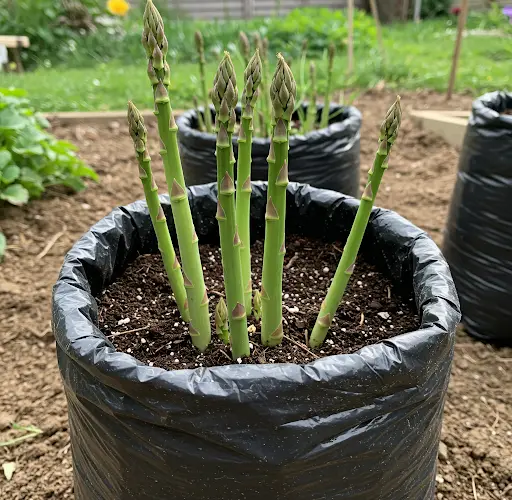Growing Asparagus in Bags for Beginners – Harvest Year-Round
Asparagus (Asparagus officinalis) is a nutrient-rich, perennial vegetable that many gardeners dream of growing, but few realize how simple it can be—especially when grown in bags. Traditionally, asparagus is planted directly in garden beds due to its long-term growing cycle and need for deep soil. However, growing asparagus in bags is a space-saving, beginner-friendly method that makes year-round harvesting possible in warm climates or controlled environments.
By using grow bags or large plastic sacks, even those with limited garden space or poor soil conditions can enjoy a steady supply of tender asparagus spears. This method not only allows for better drainage and portability but also helps control pests and weeds more easily than traditional garden beds.
Why Grow Asparagus in Bags?
-
Space-saving: Great for patios, balconies, and small yards
-
Easy maintenance: Better weed and pest control
-
Portable: Move them to follow sunlight or protect from extreme weather
-
Improved drainage: Reduces root rot and fungal issues
-
Extended harvest: With staggered planting and care, you can harvest for months
What You’ll Need
-
Large grow bags (at least 20–25 liters) or heavy-duty plastic sacks
-
Quality potting soil
-
Organic compost or aged manure
-
Asparagus crowns or seeds
-
Mulch (straw, dried leaves, or rice husk)
-
A sunny location (6–8 hours of direct sunlight per day)
-
Watering can or drip system
Step-by-Step Guide to Growing Asparagus in Bags
1. Choose Your Planting Material
While you can grow asparagus from seed, it’s much faster and more reliable to use asparagus crowns—dormant roots from one-year-old plants. Crowns usually produce harvestable spears within 1–2 years, while seed-grown plants can take 3 years to mature.
Choose healthy, firm crowns from a reputable source. Some popular varieties for bag growing include ‘Mary Washington,’ ‘Jersey Knight,’ and ‘UC 157.’
2. Prepare the Grow Bag
Select a grow bag that is at least 12 inches deep and wide, with drainage holes at the bottom. Fill it with a mix of:
-
50% potting soil
-
30% compost or aged manure
-
20% perlite, sand, or rice husk for drainage
Mix well and water lightly to settle the soil.
3. Planting the Crowns
Make a shallow trench in the center of the bag about 4 inches deep. Lay the asparagus crowns with their roots spread out like a spider, and cover with 2–3 inches of soil. As the shoots grow, gradually add more soil until the trench is filled. This encourages deep rooting and a stronger plant.
If planting seeds, sow them ½ inch deep and thin the seedlings later, leaving the strongest.
Care and Maintenance
Sunlight and Temperature
Place your grow bags in a location that receives full sun for at least 6–8 hours a day. Asparagus thrives in warm weather but can tolerate cool temperatures. In colder climates, you can move bags to a sheltered area during winter.
Watering
Keep the soil consistently moist, especially during the first year when roots are establishing. Avoid waterlogging, as asparagus roots are prone to rot in soggy conditions.
Fertilizing
Feed your asparagus every 4–6 weeks with a balanced organic fertilizer or compost tea. Aged manure can be added as a top dressing to enrich the soil over time.
Mulching
Apply a layer of mulch on top to retain moisture, suppress weeds, and regulate temperature. Straw, dried leaves, or rice husks work well.
Weeding and Pest Control
Bags help reduce weeds, but any that appear should be removed by hand. Keep an eye out for asparagus beetles or aphids. Neem oil spray or insecticidal soap can help keep pests in check.
Harvesting Asparagus
Patience is key. In the first year, avoid harvesting so the plant can build strong roots. By the second year, you can begin harvesting lightly for a few weeks. By the third year, full harvests are possible.
Harvest spears when they are 6–8 inches tall and still tightly closed at the tips. Use a sharp knife or snap them off by hand near the base. Once the spears become thin (like pencils), stop harvesting and allow the plant to rest and regenerate.
With good care, asparagus can produce for 10–15 years, even in bags!
Extending the Harvest
You can stagger planting of multiple grow bags every few weeks during the growing season. This technique provides a steady supply of asparagus instead of a single short harvest window.
In tropical or warm climates, asparagus may continue producing nearly year-round if kept healthy and not exposed to frost. In cooler zones, move the bags to a greenhouse or sheltered area in winter to prolong the season.
Final Thoughts
Growing asparagus in bags is an excellent solution for beginner gardeners, urban dwellers, and anyone looking for a long-term, low-maintenance crop. With just a little effort upfront and some patience in the first year, you’ll be rewarded with a continuous harvest of fresh, delicious spears for years to come.
This method not only conserves space but also makes it easy to monitor plant health, manage soil conditions, and adapt to different climates. Give bag-grown asparagus a try—you’ll be amazed at how productive and practical this setup can be.



